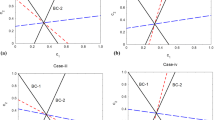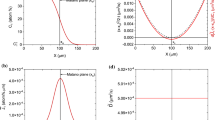Abstract
Calculated concentration dependences of interdiffusion coefficients and coefficients determining contributions of initial and boundary conditions for various alloy components into distribution of concentrations in the diffusion zone are illustrated. The analysis of these dependences shows that kinetics of component redistribution is determined by the component that diffuses slowly, which distinguishes the results of this approach from that of the generalized theories of the Darken approach.
Similar content being viewed by others
Avoid common mistakes on your manuscript.
INTRODUCTION
The majority of alloys for industrial applications have multicomponent composition and multiphase microstructure. To predict a structure and its degradation upon the production of items from alloys and under the operation condition, respectively, it is necessary to understand and describe diffusion processes in these systems [1–6]. However, peculiarities of the diffusion in multicomponent alloys require clarifying, because their origin is not always known [7–9]. In particular, this is true for the “sluggish” diffusion in high-entropy alloys [9].
In [10], the approach that has been earlier developed for the case of binary systems [11–19] is generalized to ternary alloys. Its mathematical apparatus has been developed, and the expressions for the interdiffusion coefficients that determine contributions of initial and boundary conditions into the distribution of concentrations in the diffusion zone have been derived.
In this work, the concentration dependences of the aforementioned coefficients are calculated and the plots that illustrate these dependences are given; on this basis, the peculiarities of interdiffusion in ternary alloys and possible causes for its retardation are analyzed.
SOLUTION OF SYSTEM OF DIFFUSION EQUATIONS FOR THREE COMPONENTS AND VACANCIES
In [10], basic equations for flows of vacancies and atoms in three-component system were derived by the Gurov hole gas method [3, 4]. After substitution of the expressions for flows in the continuity equations, we get the system of four nonlinear interrelated equations, which is linearized as it has been done in the case of the interdiffusion in binary systems [13]. In this case, the concentration gradients were considered to be small, because the flow equations were derived for the same conditions [3, 4], the concentrations are represented as a sum of two terms:
where \({{c}_{v}}\) is the vacancy concentration and ci is the component concentration i = 1, 2, 3, \(0 \leqslant {{\xi }} \leqslant l,\) \({{\tau }} < {{t}_{1}}.\)
The system of linearized equation for \({{u}^{i}}\) and \(v\) (see (5) in [10]) was solved using the Green’s functions for parabolic equations [20], which allowed describing the functions as series (for details see [13]):
where \({{{{\lambda }}}_{n}} = {{{{\pi }}n} \mathord{\left/ {\vphantom {{{{\pi }}n} l}} \right. \kern-0em} l}.\)
Taking into account the orthogonality of \({\text{sin}}\left( {{{{{\lambda }}}_{n}}{{\xi }}} \right),\) the system of diffusion equations in [10] was transformed into a system of integral equations for \({{\varphi }}_{n}^{i}\left( {{\tau }} \right)\) and \({{{{\varphi }}}_{n}}\left( {{\tau }} \right).\) This system of equations was solved using the Laplace transformation. The characteristic equation ((9) in [10])) has eigenvalues that determine temporal dependence of concentrations of alloy components and vacancies. In this case, the distribution of components concentration in the diffusion zone is determined \({\text{by}}\) two interdiffusion coefficients with an accuracy up to the vacancy concentration terms of the higher order. These coefficients are roots of the quadratic equation with the following coefficients:
Then, formulas for these roots are calculated as follows:
where \({{D}_{1}},~{{D}_{2}},~{{D}_{3}}\) are the self-diffusion coefficients, and \({{\varphi }}_{n}^{1}\left( p \right)\) is determined by the following expression:
where
\(u_{{0l}}^{i}\left( p \right)\) is the Laplace image of function
which determines contributions of the first-order boundary conditions set at the boundaries of interval l in the solution of the diffusion equation for component i.
To derive expression for \({{\varphi }}_{n}^{2}\left( p \right)\), in \({{\varphi }}_{n}^{1}\left( p \right)~\), it is suffice to change indices 1 → 2; 2 → 3; 3 → 1; and for \({{\varphi }}_{n}^{3}\left( p \right)\), 1 → 3; 3 → 2; 2 → 1.
Thus, temporal change in the concentration of alloy components is determined by two coefficients \({{D}^{ + }}\) and \({{D}^{ - }}.\) Besides, the form of the concentration profiles depends not only on the coefficients, but also on six remaining matrix elements of M1 (see (6)).
CONCENTRATION DEPENDENCES OF COEFFICIENTS \({{D}^{ + }}\) AND \({{D}^{ - }}\) AND MATRIX ELEMENTS M1
Coefficients \({{D}^{ + }}\) and \({{D}^{ - }}\) as well as matrix elements of M1 (6) demonstrate a complex dependence on the concentration of alloy elements. Therefore, for illustration, such dependences are calculated and plotted for some coefficients Di, which were considered independent on concentration (often used in theoretical works). So, Figs. 1 and 2 demonstrate dependences of \({{D}^{ + }}\) and \({{D}^{ - }}\) for various proportions of coefficients D1, D2, D3.
Results shown in Figs. 1, 2 suggest that for different concentrations \({{D}^{ + }}\) varies in the range between average and maximum values of self-diffusion coefficients; \({{D}^{ - }}\) varies in the range between minimal and average values of self-diffusion coefficients. This means that terms of the second column of equation (6) change slowly with time. In addition, these coefficients are essentially lower than in any cases of linearly dependent diagonal coefficients, e.g., in the generalized theories of the Darken approach for three-component alloys [4]. Besides, these deviations are maximal for the equiatomic alloy composition.
To enhance analysis, the concentration dependences of the coefficients \({{D}^{ + }}\) and \({{D}^{ - }}\) were calculated for constant concentration of one of the components. Results are demonstrated in Fig. 3.
All expressions \({{\varphi }}_{n}^{i}\left( p \right)\) have the same structure as in the case of the two-component system (see [13]). However, coefficients of functions dependent on \(p,\) which determine time dependence, have a more complicated form, and it is difficult to express them conveniently in terms of \({{D}_{i}},{{D}_{V}}\). Therefore, Figs. 4–7 demonstrate plots of concentration dependences of matrix elements of M1 for the above-described relationships of self-diffusion coefficients. Besides, the plots only represent matrix elements with higher order of vacancy concentration. First, Figs. 4 and 6 show plots for matrix elements of M1 (6), which determine contributions of the terms controlled by initial and boundary conditions for the first (see Eq. (6)) and then for the second (Figs. 5, 7) components into the dependence of the first-component concentration in diffusion zone on coordinate and time.
It is necessary to note that coefficients have the same order of magnitude. Besides, in a certain concentration range, elements of the right column of matrix M1 (6), which determine contributions of slowly changing terms (D – dependent), have higher values than those of the matrix middle column (D+ dependent). This means that in this concentration region the slow time-dependent variation of the component concentration prevails.
Figures 6 and 7 show dependences of the same matrix elements for another relationship between the self-diffusion coefficients.
The data presented demonstrate that they have similar behavior and only somewhat differ in value. Additionally, \({{D}^{ + }}\) and \({{D}^{ - }}\) are calculated for two relationships of self-diffusion coefficients, presuming that their average values are the same (Figs. 8 and 9).
Analysis of the results shown in these figures demonstrates that the higher the difference in the self-diffusion coefficients in an alloy (for the same average value), the less the \({{D}^{ - }}\) coefficient and the more pronounced retardation of the interdiffusion in equiatomic and some other alloys. In addition, under these conditions the contribution of such terms is also higher, which originates from the М matrix components.
CONCLUSIONS
Thus, in this work, concentration dependences of diffusion coefficients that determine the redistribution of the alloy components in the diffusion zone and the kinetics of the diffusion transformations are studied. The derived equations and presented figures demonstrate that these coefficients depend nonlinearly on concentration and self-diffusion coefficients. In this case, the largest of these coefficients falls in the range between average and maximal self-diffusion coefficients; the smallest one, between the minimal and average. Preliminary results show that in the ternary alloy the interdiffusion is slower than predicted by the generalized theories of the Darken approach [4]. This difference is the highest for the equiatomic alloys and for higher deviation in self-diffusion coefficients. In other words, it can be expected that the “sluggish diffusion” will be observed in alloys in which the maximal self-diffusion coefficient is five or more times larger than the minimal one.
REFERENCES
P. G. Shewmon, Diffusion in Solids (McGraw-Hill, Warrendale, 1989).
J. R. Manning, Diffusion Kinetics for Atoms in Crystals (Van Nostrand Reinhold, Princeton, 1968).
I. B. Borovskii, K. P. Gurov, I. D. Marchukova, and Yu. E. Ugaste, Processes of Mutual Diffusion in Alloys (Nauka, Moscow, 1973).
K. P. Gurov, B. A. Kartashkin, and Yu. E. Ugaste, Mutual Diffusion in Multicomponent Metallic Systems (Nauka, Moscow, 1981) [in Russian].
H. Mehrer, Diffusion in Solids – Fundamentals, Methods, Materials, Diffusion-Controlled Processes. Textbook (Springer, Berlin, 2007), Vol. 155, p. 651.
A. Paul, T. Laurila, V. Vuorinen, and S. V. Divinski, Thermodynamics, Diffusion and the Kirkendall Effect in Solids (Springer, Heidelberg, 2014).
A. van de Walle and M. Asta, “High-throughput calculations in the context of alloy design,” MRS Bull. 44, No. 4, 252–256 (2019).
E. P. George, D. Raabe, and R. O. Ritchie, “High-entropy alloys,” Nat. Rev. Mater. 4, 515–534 (2019).
S. V. Divinski, A. Pokoev, N. Eesakkiraja, and A. Paul, “A mystery of ‘sluggish diffusion’ in high-entropy alloys: the truth or a myth?,” Diffus. Found. 17, 69–104 (2018). https://doi.org/10.4028/www.scientific.net/DF.17.69
A. V. Nazarov, “On the theory of interdiffusion in ternary alloys,” Phys. Met. Metallogr. 123, No. 5, pp. 425–431 (2022).
A. V. Nazarov and K. P. Gurov, “Microscopic theory of mutual diffusion in a binary system with nonequilibrium vacancies,” Fiz. Met. Metalloved. 34, No. 5, 936–941 (1972).
A. V. Nazarov, “Uncompensated vacancy flow and the Kirkendall effect,” Fiz. Met. Metalloved. 35, No. 3, 645–649 (1973).
A. V. Nazarov and K. P. Gurov, “Kinetic theory of mutual diffusion in a binary system. Concentration of vacancies during mutual diffusion,” Fiz. Met. Metalloved. 37, No. 3, 496–503 (1974).
A. V. Nazarov and K. P. Gurov, “Kinetic theory of mutual diffusion in a binary system. Influence of the concentration dependence of self-diffusion coefficients on the process of mutual diffusion,” Fiz. Met. Metalloved. 38, No. 3, 486–492 (1974).
A. V. Nazarov and K. P. Gurov, “Kinetic theory of mutual diffusion in a binary system. Kirkendall effect,” Fiz. Met. Metalloved. 38, No. 4, 689–695 (1974).
A. V. Nazarov and K. P. Gurov, “Accounting for nonequilibrium vacancies in the phenomenological theory of mutual diffusion,” Fiz. Met. Metalloved. 45, No. 4, 885–887 (1978).
K. S. Musin, A. V. Nazarov, and K. P. Gurov, “Effect of ordering on interdiffusion in binary alloys,” Fiz. Met. Metalloved. 63, No. 2, 267–277 (1987).
A. V. Nazarov and A. A. Mikheev, “Effect of elastic stress field on diffusion,” Defect Diffus. Forum 143–147, 177–185 (1997).
A. V. Nazarov, “K.P. Gurov’s hole gas method and an alternative theory of interdiffusion,” Fiz. Khim. Obr. Mater., No. 2, 48–62 (2018).
A. N. Tikhonov and A. A. Samarskii, Equations of Mathematic Physics (Nauka, Moscow, 1972) [in Russian].
Funding
Authors acknowledge financial support of the National Research Nuclear University MEPhI “Project of Academic Superiority” (contract no. 02.a03.21.0005).
Author information
Authors and Affiliations
Corresponding author
Additional information
Translated by O. Golovnya
Rights and permissions
About this article
Cite this article
Sergeev, G.V., Makarova, V.A., Kahidze, R.Z. et al. On the Theory of Interdiffusion in Ternary Alloys: Concentration Dependences of Kinetics-Related Coefficients. Phys. Metals Metallogr. 123, 432–438 (2022). https://doi.org/10.1134/S0031918X22050155
Received:
Revised:
Accepted:
Published:
Issue Date:
DOI: https://doi.org/10.1134/S0031918X22050155













